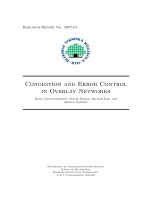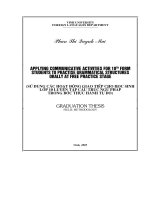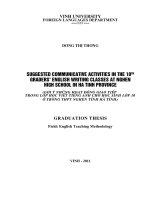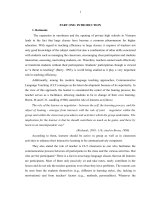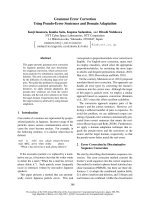Error correction in oral communicative activities students and teachers viewpoints m a thesis in tesol
Bạn đang xem bản rút gọn của tài liệu. Xem và tải ngay bản đầy đủ của tài liệu tại đây (788.13 KB, 118 trang )
VIETNAM NATIONAL UNIVERSITY – HO CHI MINH CITY
UNIVERSITY OF SOCIAL SCIENCES AND HUMANITIES
WX
M.A. THESIS IN TESOL
ERROR CORRECTION
IN ORAL COMMUNICATIVE ACTIVITIES:
STUDENTS’ AND TEACHERS’VIEWPOINTS
by:
HOÀNG THỊ PHƯƠNG THẢO
SUBMITTED IN PARTIAL FULFILMENT OF THE REQUIREMENTS FOR
THE DEGREE OF MASTER IN TESOL
SUPERVISED BY:
NGUYỄN THỊ THANH PHƯỢNG, PH.D.
HO CHI MINH CITY APRIL, 2009
CERTIFICATE OF ORIGINALITY
I hereby certify my authorship of the thesis submitted today entitled:
Error Correction in Oral Communicative ActivitiesStudents’ and Teachers’ Viewpoints
In terms of the Statement of Requirements for Theses in Master’s Programmes
issued by the Higher Degree Committee.
Ho Chi Minh City 2009
Hoàng Thị Phương Thảo
i
ACKNOWLEDGEMENTS
I would like to thank with all my heart to people who have helped me to
complete this research project: Dr. Nguyen Thi Thanh Phuong, my dear advisor, who
has guided me and encouraged me with great energy and endless faith in my abilities.
Her useful suggestions, direction and encouragement were really invaluable; all my
teachers and staff at Department of English Linguistics and Literature who have given
me useful advice and direction and kept me going in the right direction.
I sincerely thank hundreds of teachers and students who gave me priceless
responses and the administration and staff of Youth Foreign Language School, Ho
Chi Minh City. I would not have finished this study without their help.
I would like to convey my gratitude to all my friends, my classmates, my
colleagues who have supported, encouraged and given me useful comments and
advice throughout my studies.
Finally and most importantly, I would like to express my special thanks to my
family: my husband, my son, my parents, my sisters and brothers, my nieces and
nephews. Their love support, encouragement, understanding and belief have carried
me throughout the writing of this research. I could not have completed my studies
without them.
ii
TABLE OF CONTENTS
CERTIFICATE OF ORIGINALITY................................................................................... i
ACKNOWLEDGEMENTS................................................................................................ ii
ABSTRACT...................................................................................................................... vii
LIST OF TABLES............................................................................................................. ix
LIST OF ABBREVIATIONS............................................................................................ xi
1.CHAPTER 1: INTRODUCTION .................................................................................... 1
1.1
STATEMENT OF PROBLEM........................................................................... 1
1.2
PURPOSE OF THE STUDY.............................................................................. 3
1.3
RESEARCH DESIGN ........................................................................................ 4
1.3.1 Research Questions ............................................................................................ 4
1.3.2 Data Collection Procedures................................................................................ 4
1.3.3 Delimitations and Limitations............................................................................ 5
1.3.3.1 Delimitations............................................................................................... 5
1.3.3.2 Limitations .................................................................................................. 5
1.3.4 Assumptions....................................................................................................... 6
1.4
DEFINITION OF TERMS ................................................................................. 6
1.5
SIGNIFICANCE OF THE STUDY.................................................................... 8
1.6
ORGANIZATION OF THE STUDY................................................................. 9
2. CHAPTER 2: LITERATURE REVIEW ...................................................................... 10
2.1 ERRORS IN FOREIGN LANGUAGE LEARNING............................................. 10
2.1.1 Types of Errors ................................................................................................ 11
iii
2.1.1.1 Overt Errors and Covert Errors:................................................................ 11
2.1.1.2 Global Errors and Local Errors:................................................................ 11
2.1.2 Sources of Errors.............................................................................................. 13
2.1.2.1 Interlingual Transfer ................................................................................. 13
2.1.2.2 Intralingual Transfer ................................................................................. 13
2.1.2.3 Context of Learning .................................................................................. 13
2.1.2.4 Communication Strategies ........................................................................ 14
2.2 DIFFERENT VIEWPOINTS ABOUT ERROR TREATMENT IN FOREIGN
LANGUAGE TEACHING........................................................................................... 14
2.2.1 Which Errors should be Corrected? ................................................................. 15
2.2.2 When should Errors be Corrected? .................................................................. 16
2.2.3 Who should Correct the Errors ........................................................................ 17
2.2.4 How should Errors be Corrected...................................................................... 17
2.3 ERROR TREATMENT IN ORAL COMMUNICATIVE ACTIVITIES .............. 19
2.3.1 Oral Communicative Activities ....................................................................... 19
2.3.2 Error Correction in Oral Communicative Activities........................................ 20
2.4 STUDENTS’ PREFERENCES .............................................................................. 23
2.5 SUMMARY............................................................................................................ 24
3. CHAPTER 3: METHODOLOGY ................................................................................ 25
3.1
RESEARCH DESIGN ...................................................................................... 25
3.2
POPULATION AND SAMPLE ....................................................................... 27
3.3
INSTRUMENTS............................................................................................... 28
iv
3.3.1 Description of the Questionnaires.................................................................... 29
3.3.2 Pilot Test .......................................................................................................... 30
3.4
PROCEDURES FOR DATA COLLECTION.................................................. 31
3.5
PROCEDURES FOR DATA ANALYSIS....................................................... 32
3.6
SUMMARY...................................................................................................... 33
4. CHAPTER 4: DATA ANALYSIS AND FINDINGS .................................................. 34
4.1 DESCRIPTIVE ANALYSIS OF THE PARTICIPANTS ...................................... 34
4.1.1 The Students..................................................................................................... 34
4.1.2 The Teachers .................................................................................................... 36
4.2 RESEARCH QUESTION 1: STUDENTS’VIEWPOINTS ................................... 38
4.3 RESEARCH QUESTION 2: TEACHERS’VIEWPOINTS ................................... 45
4.4 RESEARCH QUESTION 3: COMPARISONS OF STUDENTS’ AND
TEACHERS’ VIEWPOINTS ....................................................................................... 55
4.6 SUMMARY............................................................................................................ 68
5.CHAPTER 5: CONCLUSIONS AND RECOMMENDATIONS................................. 69
5.1 OVERVIEW OF THE RESEARCH STUDY ........................................................ 69
5.2 SUMMARY OF THE FINDINGS ......................................................................... 70
5.3 RECOMMENDATIONS........................................................................................ 72
5.3.1 Recommendations for Teachers of Communicative Classes........................... 73
5.3.2 Recommendations for Students of Communicative Classes ........................... 74
5.3.3 Recommendations for Future Research ........................................................... 75
5.4 CONCLUSIONS .................................................................................................... 76
v
REFERENCES ................................................................................................................. 79
APPENDICES .................................................................................................................. 83
APPENDIX A STUDENT QUESTIONNAIRE ......................................................... 83
APPENDIX B TEACHER QUESTIONNAIRE ......................................................... 86
APPENDIX C STUDENT QUESTIONNAIRE (VIETNAMESE VERSION) .......... 89
APPENDIX D TEACHER QUESTIONNAIRE (VIETNAMESE VERSION).......... 92
APPENDIX E STATISTICS FROM STUDENTS’ RESPONSES............................. 95
APPENDIX F STATISTICS FROM TEACHERS’RESPONSES.............................. 97
APPENDIX G INDEPENDENT SAMPLES TEST RESULTS FROM STUDENTS
AND TEACHERS’RESPONSES................................................................................. 99
vi
ABSTRACT
Making errors and mistakes is unavoidable in foreign language learning and
correcting students’ errors and mistakes is an important part of language teaching.
However, different theories of foreign language learning and teaching have different
viewpoints on what, when and how to correct errors and mistakes. In Vietnam, there are a
lot of “communicative classes” which stress on the use of English as a mean of
communication. In these classes, oral communicative activities are frequently used and
teachers tend not to correct all student’s errors and mistakes. However, some students
complained about their teacher’s practices. This study was carried out to examine
whether there was a difference between students’ preferences and expectations and
teachers’ beliefs about error correction in oral communicative activities.
The descriptive, quantitative methodology was selected and statistical analyses
were used to find the answers to the research questions. Questionnaires with close-ended
questions, multiple- choice questions and statements with Likert-scale were used to
collect data from 195 students and 21 teachers of Youth Foreign Language School in Ho
Chi Minh City. The data then was analyzed using SPSS (Statistic Package for Social
Science) software to find the results.
The findings showed that students expected their teachers to correct their errors
immediately by giving them the correct answer rather than ignoring the errors or just
indicating that there was something wrong and letting them to correct themselves. They
also did not want their teachers to let them speak freely without correction. Teachers
vii
believed that correction their students’ errors and mistakes was one of their most
important responsibilities, therefore, they tended to correct every error when they heard
it. Some of them tried to correct their students’ errors as soon as they found them and
other delay correction until the end of the activities. The results also indicate that students
and teachers are affected greatly by traditional method of learning and teaching which
emphasizes on accuracy rather than fluency, therefore, teachers should find an error
correction strategy that can harmonize traditional and “new” methods of learning and
teaching so that they can help students perform better in oral communicative activities.
viii
LIST OF TABLES
Table 1: Descriptive Analysis of Student Participants
Table 2: Descriptive Analysis of Teacher Participants
Table 3: S1 “I am not afraid of making errors when I am speaking in class”
Table 4: S2 When I make an error, I feel:
Table 5: S3 I don’t want my teacher to correct my mistakes when I am speaking in class
Table 6: S4 Among these types of errors: phonological errors, syntactic errors, lexical errors,
discourse errors, the errors that I want to be corrected most are
Table 7: S5 I prefer my teacher to correct my errors immediately rather than after the activity
35
37
39
39
40
40
41
Table 8: S6 When my teacher corrects my errors immediately, I feel:
41
Table 9: S7 when my teacher corrects my errors after the activity, I feel:
41
Table 10: S8 When I make an error, I want:
42
Table 11: S9 When I make an error, the ways I want it to be corrected most are
42
Table 12: S10 When I know my friends are making an error but my teacher does not correct, I
43
think the reason is:
Table 13: S11 Generally, I want my teacher to let us speak freely without correction:
43
Table 14: S1 I think my students are not afraid of making errors when they are speaking in class
46
46
Table 15: S2 when my students make an error, they feel:
Table 16: S3 My students don’t want me to correct their mistakes when they are speaking in class
47
Table 17: S4 Among these types of errors: phonological errors, syntactic errors, lexical errors,
48
discourse errors, I think the errors need to be corrected most are:
Table 18: S5 Correcting immediately is more effective than delaying after the activity.
49
Table 19: S6 My students don’t want me to correct immediately
49
Table 20: S7 My students will not remember the mistakes if they are corrected after the activity
Table 21: S8 When I find an error, I think I should
Table 22: S9 If the errors should be corrected, I think I should
Table 23: S10 If my students make an error and I don’ t correct it, my students might think the
reason is
Table 24: S11 Generally, I want to let my students speak freely without correction
Table 25: Crosstabulation of S1 and groups
Table 26: Mean, Standard Deviation, Median, Mode by teacher and student groups for S1
Table 27: Crosstabulation of S2 and groups
Table 28: Mean, Standard Deviation, Median, Mode by teacher and student groups for S2
Table 29: Crosstabulation of S3 and groups
Table 30: Mean, Standard Deviation, Median, Mode by teacher and student groups for S3
Table 31: Crosstabulation of S4-1 and groups
Table 32: Mean, Standard Deviation, Median, Mode by teacher and student groups for S4-1
50
52
52
53
53
56
56
57
57
58
58
59
59
ix
Table 33: Mean, Standard Deviation, Median, Mode by STUDENT group for S5, S6, and S7
60
Table 34: Mean, Standard Deviation, Median, Mode by TEACHER group for S5, S6, and S7
Table 35: Crosstabulation of S8-1 and groups
Table 36: Mean, Standard Deviation, Median, Mode by teacher and student groups for S8-1
Table 37: Crosstabulation of S8-2 and groups
Table 38: Mean, Standard Deviation, Median, Mode by teacher and student groups for S8-2
Table 39: Crosstabulation of S9 and groups
Table 40: Mean, Standard Deviation, Median, Mode by teacher and student groups for S9
Table 41: Crosstabulation of S10-1 and groups
Table 42: Mean, Standard Deviation, Median, Mode by teacher and student groups for S10-1
Table 43: Crosstabulation of S10-2 and groups
Table 44: Mean, Standard Deviation, Median, Mode by teacher and student groups for S10-2
Table 45: Crosstabulation of S11 and groups
Table 46: Mean, Standard Deviation, Median, Mode by teacher and student groups for S11
60
61
61
62
62
63
63
64
64
64
65
65
65
x
LIST OF ABBREVIATIONS
CA:
Communicative Approach
CLT:
Communicative Language Teaching
L1:
First language/ Native language
L2:
Second language/ Target language
OCA:
Oral Communicative Activity
S:
Statement
SPSS:
Statistic Package for Social Science
YFLS:
Youth Foreign Language School
xi
1.CHAPTER 1: INTRODUCTION
1.1 STATEMENT OF PROBLEM
Making errors and mistakes is part of the process of foreign language learning and
correcting students’ errors and mistakes is a part of foreign language teaching (Edge J.,
1989). However, depending on the theories of language learning and methodologies,
there are different viewpoints about what, when and how to correct students’ errors and
mistakes. Ur P. (2000) summarizes these viewpoints as follows:
Audio-lingualism: learner mistakes are, in principle, avoided by the
limiting of progress to very small, controlled steps: hence there should be little
need for correction. The latter (positive assessment) is, in any case, not useful for
learning; people learn by getting things right in the place and having their
performance reinforced.
Cognitive-code learning: Mistakes are regrettable, but an unavoidable
part of learning: they should be corrected whenever they occur to prevent them
occurring again.
Interlanguage: Mistakes are not regrettable, but an integral and important
part of language learning; correcting them is a way of bringing the learner’s
“interlanguage” closer to the target language (Selinker, 1972, 1992).
Communicative Approach: Not all mistakes need to be corrected: the
main aim of language learning is to receive and convey meaningful messages, and
correction should be focused on mistakes that intervene with this aim, not on
inaccuracies of usage.
Monitor theory: Correction does not contribute to real acquisition of the
language, but only to the learner’s conscious “monitoring” of speech or writing.
Hence the main activity of the teacher should be to provide comprehensible input,
from which the learner can acquire the language, not to correct (Krashen, 1982)
(Ur P., 2000,p. 244)
1
In recent years, there has been a growth in the teaching and learning English for
communication in Vietnam, especially when Vietnam joins the WTO. Many people are
now aware of the necessity of learning English for communication, not just for exams.
Therefore, there are a lot of classes of “English for Communication” in language schools
and language centers which aim at helping students to use English as a mean of
communication. These classes have attracted a lot of students who want to study English
for communicative purposes.
Because these classes usually apply Communicative Approach, which “stresses
the importance of providing learners with opportunities to use their English for
communicative purposes” (Howatt, 1984,p. 279), “communicative activities” - “any
activity – talk, task, problem project- that involves learners in “real” communication”
(Stern H.H., 1993) are used. Some of the examples of the most commonly used oral
communicative activities are giving and following instructions, information transfer,
information gap, jigsaw, problem solving, informal talk tasks, role-play, drama
techniques, and scenarios etc. (Stern H.H., 1993). Oral communicative activities give
learners opportunities to communicate in a meaningful and authentic way.
Due to the nature of the Communicative Approach which focuses on students’
fluency rather than on students’ accuracy, teachers tend not to correct students’ errors and
mistakes, especially in oral interactions.
However, many teachers have experienced some kinds of reactions from their
students, such as “Am I correct?”, “Did I say incorrectly?” or “I don’t want to speak
2
because I don’t know whether I am correct or not”, “I want to speak to teacher because
you can correct my mistakes”, or
“Why don’t you correct our mistakes?”, etc.
These reactions from students show that their expectations towards error
correction seem not compatible with teachers’ beliefs, or a gap might exist between
teachers’ beliefs and students’ expectations in error correction in communicative
activities.
Therefore, in order to understand the problem more precisely, a research into
students’ and teachers’ viewpoints on error treatment in oral communicative activities
should be conducted.
1.2 PURPOSE OF THE STUDY
The purpose of this study was three-fold: (1) to investigate the students’
viewpoints on error correction in oral communicative activities, (2) to examine the
teachers’ viewpoints about error correction in oral communicative activities and (3) to
compare teachers and students’ viewpoints to find out whether teachers’ beliefs and
students’ expectations in error correction in oral communicative activities agree with or
differ from each other and then give some recommendations on how to improve learning
and teaching English in communicative classrooms in Vietnam.
3
1.3 RESEARCH DESIGN
1.3.1 Research Questions
This study was designed to answer the three following research questions:
1. What are students’ viewpoints on teachers’ error treatments in oral
communicative activities?
2. What are teachers’ viewpoints on students’ errors and error treatments in oral
communicative activities?
3. How do students’ viewpoints agree with, or differ from teachers’ ones?
As the problem being investigated was large, multifaceted and involved a lot of
participants, a descriptive, quantitative methodology with statistical analyses was selected
to find the answers to the research questions. Questionnaires with multiple- choice
statements, statements with Likert-scale and statements using rank-ordered scales were
used because collecting and comparing large number of perceptions, attitudes, opinions,
etc. are difficult with open interviews which use open questions to obtain the data
(Seliger and Shohamy, 2000).
1.3.2 Data Collection Procedures
The questionnaires were translated into Vietnamese and were given to 21 teachers
and 195 students of English classes at Youth Foreign Language School (YFLS). The
students were studying in “English communication classes” which were of different
levels of proficiency: Elementary, Pre-intermediate, and Intermediate. The responses to
4
the questionnaires then were collected and analyzed using SPSS (Statistic Package for
Social Sciences) software to find the results.
1.3.3 Delimitations and Limitations
1.3.3.1 Delimitations
“Delimitations address how the study will be narrowed” (Creswell, 1994, p. 110).
This study was restricted to error treatments in oral communicative activities and thus did
not address error treatments in other activities, such as presentation of grammar points or
controlled practices. This study was carried out in a foreign language school, Youth
Foreign Language School (YFLS), among students of Elementary, Pre-Intermediate and
Intermediate levels of English proficiency and teachers who taught these classes, thus any
conclusions made about error treatments in this study were limited to this school and
students of Elementary, Pre-intermediate and Intermediate levels and teachers who taught
these classes, the study did not cover those in other kinds of classes or other levels of
proficiency.
1.3.3.2 Limitations
“ Limitations identify potential weakness of the study” (Creswell, 1994, p. 110).
The nature of the study and the research methods of data collection, which used
questionnaire to gather information from a purposive sample, can decrease the
generalizations of the results. The results of the study may not be satisfactory enough due
to the lack of time as well as experience of the researcher. Moreover, the
5
recommendations were limited to communicative classes in YFLS, although the findings
may be beneficial to others.
1.3.4 Assumptions
This study was based on these assumptions:
-
The sample represented the population of communicative classes at YFLS and
these classes really used oral communicative activities.
-
The data collection and data analysis procedures were appropriate to answer
the research questions.
-
The respondents understood every item of the questionnaires and answered
the questions honestly.
1.4 DEFINITION OF TERMS
Berg (2001,as cited in Phuong Nguyen, 2005) noted that the practice of
operationally defining terms allows everyone to be on the same level of understanding as
the researcher who determines the meaning to be applied throughout the research. To
reduce confusion and facilitate the overall analysis in this study, definitions for the key
terms were established
Communicative Activities: Harmer J. (1992), Stern H. (1993) state that
communicative activities are activities that give students the opportunity to communicate
meaningfully in the target language. Some of the communicative activities suggested by
6
Stern H. (1993) are: short-term visit to target language community, student exchange, L2
day or lunch meeting , student-teacher interaction, invited native guest speakers, topics
and activities arising from learners’ personal life, classroom activities: information
transfer, information gap, jigsaw, problem solving, role-play, drama techniques… (p.
184).
Communicative Approach: according to Platt J. & Platt H. (1992), communicative
approach is also called communicative language teaching and is referred to approach to
foreign language teaching which emphasizes that the goal of language learning is
communicative competence. Harmer J. (1992) and Nunan D. (1999) also state that
communicative approach concentrates on helping learners to communicate meaningfully
in a target language. Doggett G. (1986) summarizes communicative approach as an
approach which focuses on the need to teach communicative competence, functions, not
forms, are emphasized and students work with authentic materials in small groups on
communicative activities. Thus, in communicative approach, students learn to use
language to communicate with each other, such as requesting, describing, expressing
themselves, etc. they can also use language to perform different tasks, and interact with
other people, etc.
Communicative Classes: the term is used to refer to classes in which
communicative activities are incorporated at different stages of the learning process. The
communicative classes are close to the “balanced activities approach” suggested by
Harmer J. (1992) in which
“the programme will be planned on the basis of achieving a balance between the
different categories of input and output where roughly-tuned input and
7
communicative activities will tend to predominate over controlled language
presentation and practice output.” (p. 42)
Errors: Longman Dictionary of Language Teaching and Applied Linguistics (Platt
J. & Platt H., 1992) defines:
In the speech or writing of a second or foreign language learner), the use of a
linguistic item (e.g. a word, a grammatical item, a speech act, etc.) in a way which
a fluent or native speaker of the language regards as showing faulty or incomplete
learning. Errors are sometimes classified according to vocabulary (lexical error),
pronunciation (phonological error), grammar (syntactic error), misunderstanding
of a speaker’s communicative effect, e.g. through the faulty use of speech act or
one of the rules of speaking (pragmatic error).
(p. 122)
Mistakes: a mistake made by a learner when writing or speaking and which is
caused by lack of attention, fatigue, and carelessness, etc. Platt J. & Platt H. (1992) also
believe that mistakes and errors are the same (p. 127).
Oral Communicative Activities: communicative activities that “provoke spoken
communication between students and/or between the teacher and the students” (Harmer
J., 1992,p. 122). Harmer J. (1992) also suggests some oral communicative activities such
as: reaching a consensus, discussion, relaying instruction, communication game, problem
solving, talking about yourself, simulation and role-play, etc.
1.5 SIGNIFICANCE OF THE STUDY
This study is significant in two ways. First, this study helps teachers to learn more
about their students and their students’ preferences and expectations in a particular area
of language teaching, error correction. The findings of this research will help teachers
8
decide appropriate strategies to correct students’ errors as researchers and educators
(Harmer, 1992; Nunan, 1999; Ur, 2000) believe that language learning is more successful
when the teachers’ beliefs and practices are matched with students’ preferences and
expectations.
Second, this study fills the gaps of previous research. Indeed, there are several
studies conducted about error correction, but not many of them were about correction in
oral communicative activities, especially in the Vietnamese classrooms where students
are still affected by “traditional” learning methods which emphasize on accuracy rather
than fluency.
1.6 ORGANIZATION OF THE STUDY
This study is organized as follows: Chapter 1 introduces the study. Chapter 2
presents a review of literature and research relevant to this study. Chapter III describes
the research design and methodology. Chapter IV offers the discussions and analyses of
the findings. Chapter V gives the summary and conclusions of the study with some
recommendations for further research in the area of English language teaching in
Vietnam
9
2. CHAPTER 2: LITERATURE REVIEW
This chapter presents the review of literature and research about errors in foreign
language learning, different viewpoints about error treatment in foreign language
teaching and learning, error treatment in oral communicative activities and students’
preferences about error correction.
2.1 ERRORS IN FOREIGN LANGUAGE LEARNING
Making errors is an integral part of language learning, because like any other
human learning, language learning is a process that involves the making of errors and
mistakes (Brown, 2000). Numerous educators and researchers (Brown, 2000; Littlewood,
1987) also believe that when learners make errors, the learning is taking place and in
turn, learners can benefit from the form of feedback on those errors.
Many researchers and teachers agree that a distinction between mistakes and
errors is very important (Brown, 2000; Corder, 1967).
A mistake is a product of the learner when a learner fails to use a known system
correctly and is caused by a number of factors, such as over-enthusiasm, overgeneralization of rules, interfere from the mother tongue, etc. (Mumford & Darn, 2007)
everyone can make mistakes, native speakers or language learners. A mistake is
unsystematic and can be self-corrected (Brown, 2000)
An error, on the other hand, is repetitive and systematic and reflects a learner’s
competence. An error may be a product of the learner’s stage of language development,
10
or inappropriate teaching or learning (Mumford & Darn, 2007). Errors cannot be selfcorrected and need to be dealt with by teaching or reteaching.
2.1.1 Types of Errors
An error can be categorized in a variety of ways.
2.1.1.1 Overt Errors and Covert Errors:
Corder (1971, as cited in Brown, 2000) suggests that we should identify whether
an error is overt or covert. Overt erroneous sentences are sentences that are
grammatically incorrect whereas covert erroneous sentences are sentences that are
grammatically correct, but are used inappropriate in the context of communication and
then cause misunderstanding or uninterpretable.
For instance, the sentence “I student” is an overt erroneous sentence and the
correct sentence must be “I’m a student”. But “I’m a student” is erroneous if a learner
uses it to answer the question “Where are you from?”
Brown (2000) suggests a “simpler and more straightforward terms” for overt and
covert errors are “sentence level” errors and “discourse level” errors.
2.1.1.2 Global Errors and Local Errors:
According to Burt & Kiparsky (as cited in Brown, 2000), an error can be viewed
as global or local.
Global errors hinder communication and prevent the hearer from understanding
the speaker’s message. Local errors, on the other hand, do not prevent the hearer from
11
understanding because they are only minor mistakes and the hearer can still guess the
meaning.
“Well, it’s a hurry round there” is a global error because it is difficult or
impossible to understand this sentence in many contexts whereas “a trouser” is a local
error because it can be understood in many situations (Brown, 2000)
An error can also be classified at the levels of the language or linguistic type: an
error can be a lexical error – vocabulary, a phonological error – pronunciation, a
syntactic error – grammar, an interpretive error – misunderstanding of a speaker’s
intention or meaning or a pragmatic error – failure to apply the rules of conversation.
However, Brown (2000) states that it is not always easy to identify errors at the levels of
language; for instance, a phonological error can also be a lexical error or syntactic error.
Donald (2007) suggests that errors can also be categorized by the reason for its
production:
-
Pre-systematic: error as the result of random guess
-
Systematic: error produced while testing out hypotheses
-
Post-systematic: a slip of tongue, a lapse, a mistake caused by carelessness,
fatigue
12
2.1.2 Sources of Errors
Making errors is inevitable in the process of learning language. There are some
causes for the making of errors in language learning.
2.1.2.1 Interlingual Transfer
Edge (1990) points out that Interlingual Transfer is the significant cause of errors
for all learners. Especially at the beginning stages of learning, learners are easily
influenced by their first language. We can usually find these errors in pronunciation or
vocabulary and grammar. When learners do not know how to say something in English,
they tend to use words and structures from their language and try to fit it into foreign
language (Edge, 1990, p. 7).
2.1.2.2 Intralingual Transfer
It is now believed that negative intralingual transfer or overgeneralization is a
major source of errors in second language learning. Researchers (Taylor, 1975) found out
that as learner’s progress in the second language, their previous experience and their
existing subsumes begin to include structures within the target language itself. Some of
examples of the errors caused by intralingual transfer are:
-
past tense form of the verb following a modal
-
present tense –s on a verb following a modal
-
-ing on a verb following a modal, etc.
2.1.2.3 Context of Learning
According to Brown (2000), “in a classroom context, the teacher or textbook can
lead the learners to make faulty hypotheses about the language” (p. 226). A misleading
13

